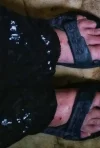LesBrass
Likes Walking
- Time of past OR future Camino
- yes...
I've never heard of these little blighers before! I know about them now!! They are called Trombiculidae can are often called chiggers... or berry bugs, harvest mites, red bugs, scrub-itch mites and aoutas in France).
After my walk on Thursday I developed 27 blistery red hot 'worst itch ever' bites! ARGHHH... they are horrible! So if you are walking now take care in longer grass! This is the first time I've been bitten so maybe the wet summer has been good for chiggers?



This if from wikipedia...
Trombiculid mites go through a lifecycle of egg, larva, nymph, and adult.[15] The larval mites feed on the skin cells of animals. The six-legged parasitic larva feeds on a large variety of creatures, including humans, rabbits, toads, box turtles, quail, and even some insects. After crawling onto their hosts, they inject digestive enzymes into the skin that break down skin cells. They do not actually "bite", but instead form a hole in the skin called a stylostome and chew up tiny parts of the inner skin, thus causing severe irritation and swelling. The severe itching is accompanied by red, pimple-like bumps (papules) or hives and skin rash or lesions on a sun-exposed area. For humans, itching usually occurs after the larvae detach from the skin.[16]
After feeding on their hosts, the larvae drop to the ground and become nymphs, then mature into adults which have eight legs and are harmless to humans. In the postlarval stage, they are not parasitic and feed on plant material. The females lay three to eight eggs in a clutch, usually on a leaf or under the roots of a plant, and die by autumn.[16]
After my walk on Thursday I developed 27 blistery red hot 'worst itch ever' bites! ARGHHH... they are horrible! So if you are walking now take care in longer grass! This is the first time I've been bitten so maybe the wet summer has been good for chiggers?
This if from wikipedia...
Trombiculid mites go through a lifecycle of egg, larva, nymph, and adult.[15] The larval mites feed on the skin cells of animals. The six-legged parasitic larva feeds on a large variety of creatures, including humans, rabbits, toads, box turtles, quail, and even some insects. After crawling onto their hosts, they inject digestive enzymes into the skin that break down skin cells. They do not actually "bite", but instead form a hole in the skin called a stylostome and chew up tiny parts of the inner skin, thus causing severe irritation and swelling. The severe itching is accompanied by red, pimple-like bumps (papules) or hives and skin rash or lesions on a sun-exposed area. For humans, itching usually occurs after the larvae detach from the skin.[16]
After feeding on their hosts, the larvae drop to the ground and become nymphs, then mature into adults which have eight legs and are harmless to humans. In the postlarval stage, they are not parasitic and feed on plant material. The females lay three to eight eggs in a clutch, usually on a leaf or under the roots of a plant, and die by autumn.[16]


















